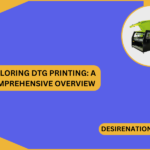In the dynamic world of printing technologies, DTF (Direct to Film) printing has emerged as an innovative method that offers versatility and vibrant results. DTF printing combines the best of direct-to-garment (DTG) and heat transfer printing, making it an increasingly popular choice for creating customized and detailed prints on fabrics. In this comprehensive guide, we’ll delve into what DTF printing is, how it works, and the advantages that make it stand out in the realm of textile printing.
What is DTF Printing?
DTF printing, or Direct to Film printing, is a digital printing method specifically designed for printing on fabrics, textiles, and garments. Unlike traditional screen printing or heat transfer methods, DTF printing involves directly applying ink to a special film, which is then transferred onto the fabric using a heat press. This innovative approach allows for intricate designs, vibrant colors, and efficient printing on a variety of materials.
How Does DTF Printing Work?
- Preparation of the Design: The DTF printing process begins with the creation or selection of a digital design. This design is then printed onto a special release film using a DTF printer. The film is designed to hold the ink and act as a carrier for the design.
- Applying Adhesive Layer: After printing the design, an adhesive layer is applied to the film. This adhesive serves as a bond between the ink and the fabric during the transfer process.
- Heat Press Transfer: The prepared film is then placed on the fabric, and a heat press is used to transfer the design. The heat activates the adhesive, causing it to bond with the fabric, while the ink is released from the film and permanently adheres to the fabric.
- Peeling and Finishing: Once the transfer is complete, the film is peeled away, leaving the vibrant and detailed design on the fabric. The fabric is now ready for use, and the DTF printing process is complete.
Advantages of DTF Printing:
- Versatility: DTF printing is highly versatile, allowing for the printing of intricate and detailed designs on various fabrics, including cotton, polyester, blends, and even dark-colored fabrics.
- Color Vibrancy: The direct application of ink onto the film enables DTF printing to achieve vivid and vibrant colors, ensuring that the final print is visually striking and true to the original design.
- Intricate Details: DTF printing excels at reproducing fine details and complex designs with high precision. This makes it an ideal choice for printing graphics, photographs, and intricate patterns.
- No Limitation on Colors: Unlike traditional screen printing, DTF printing allows for a limitless range of colors in a single print, making it suitable for creating eye-catching and multicolored designs.
- Ease of Customization: DTF printing enables easy customization for one-of-a-kind or small-batch prints. This is particularly advantageous for businesses or individuals looking to create personalized garments or promotional items.
Conclusion:
DTF printing has revolutionized the world of textile printing by offering a blend of versatility, color vibrancy, and intricate detailing. As a cutting-edge technology, DTF printing continues to gain popularity in the garment decoration industry for its ability to produce high-quality and customized prints. Whether you’re a business looking to offer personalized merchandise or an individual seeking unique apparel, DTF printing provides a compelling solution for bringing your designs to life with precision and vibrancy.
You Might Also Like These:
How to Change Ink in a Canon Printer
How to print double sided on mac












